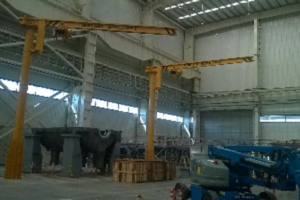Best Jib Crane Manufacturer
Are you looking for an overhead lifting machine for your production?
Jib Crane is an answer.
Jib Cranes are a type of Material Handling Equipment with a horizontal Girder called Jib or Boom. Brady & Morris Engineering co. ltd. has vast experience in manufacturing Jib Cranes. Generally, Jib Cranes are installed in industry premises where lifting and moving of heavy items are done on a regular basis. They have extended horizontal arms fixed with movable hoists for moving or lifting heavy objects. In addition, they are a versatile option for maximizing your, production process as they are considered an efficient, choice when your production needs special and repetitive lifting of objects.
Overall, they improve productivity, enhance workers safety and reduce injuries. Brady Morris is one of the best Jib Crane manufacturers and suppliers in India for overhead lifting machines for your production with workstations in Ahmedabad.
Design Aspects of Jib Crane Manufacturer –

• Reach or Boom: Horizontal beam attached to the movable trolley
• Pillar: Vertical beam that supports the boom and mast of the system
• Movable Hoist/Trolley: The hoist and the trolley can be manual or electronic. It is used for moving and lifting objects
• Rotation Stop: It limits the movement of the crane to the wall or obstruction to avoid a collision
• Controls: Jib Crane Manufacturer creates with push-button controllers and or variable speed controls
Types of Jib Cranes-
Wall- Mounted Jib Cranes –
A wall-mounted jib crane is a space-saving and versatile crane. They can be fixed in individual bays and do not require a floor foundation. They are easy to install and can be electrically or manually operated.
Freestanding Jib Cranes –
Free Standing jib cranes are the most popular form of cranes in the industry. They are simple to use and portable. They can be installed indoors or outdoors and can be manually or electrically operated.
Pillar type Jib Cranes –
Pillar type of Jib Cranes can be installed on a simple six inches of concrete for support. Further support is given by the overhead structure or the beam. They can move 360-degree rotation and can be electrically or manually operated.
Features of MORRIS Jib Cranes-
• Manufacturing capacity up to 20T depending on type of Jib Crane
• Customizable as per client’s requirement
• Available with Manual, Electric and Hybrid Operations
• Manufactured for both Hazardous Application (Flameproof) and Safe Area
• Registered and Approved by MECON, CET, WAPCOS, EIL, Tata Consultancy, Various Municipal Corporations and PHED etc.
Brady & Morris Engineering Co Ltd is considered one of the best Jib Crane Manufacturers in the country. Proper inspection and testing of Jib Cranes is done to ensure safety, efficiency, capacity, performance, lifting speed, cable strength and much more. We are experts in designing and manufacturing customized material handling equipment with the best quality.
Frequently Asked Questions (FAQs) On Jib Crane In India
JIBs or jib arms are the horizontal or near-horizontal beams used in many types of cranes to support loads away from the main support. An archaic spelling is gib. Jib arms are usually attached to vertical masts or towers or occasionally to inclined booms.
A jib is a fixed steel arm on a crane from which lifting ropes hang. For example, a tower crane’s top T section or a crawler crane’s front T section. A boom is an extendable arm on a mobile crane that extends by hydraulics. A jib is sometimes attached to the end of a mobile crane’s boom
On film sets, jib crane operators are in charge of setting up and operating all cranes. In addition to this, you may need to use equipment ranging from a small jib arm, which makes slight camera movements up and down, to a 90-foot long crane for shooting crowds or action sequences.
Radius (distance along the ground to the load) is measured as (r)(hC)/100. Lifting height times capacity is measured as hC. Capacity is specific to the length and angle of the boom arm and must be calculated in a table, such as the one provided in the resources.
It is possible for the crane to lift 18 metric tons (39,690 pounds) of weight, but the crane cannot lift that much weight when the load is attached to the end of the jib. The closer the load is to the mast, the more weight the crane can handle safely. You can tell the relationship by the 300 tonne-meter rating.
Testimonials
“I am pleased to convey my appreciation for the excellent work done… The implementation of drag chain system for CT motion is a remarkable innovation.”
– Jamshedpur Utilities and Services Co.
“Brady & Morris Engineering successfully manufactured and delivered 358 Chain Pulley Blocks and 40 Electric Wire Rope Hoists for Kakrapur Atomic Power Project and Rajasthan Atomic Power Project. We really appreciate the work done by the Brady & Morris Team.”
– Nuclear Power Corp. of India
“We erected a 35 MW Turbine and Alternator weighing 62 Tonnes with the help of Brady & Morris manufactured EOT crane on our foundation safely and without any difficulty. We thank each one in Brady & Morris, who has contributed to this major mile stone.”
